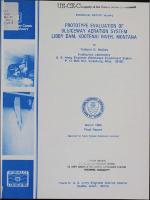Please use this identifier to cite or link to this item:
https://hdl.handle.net/11681/13184| Title: | Prototype evaluation of sluiceway aeration system, Libby Dam, Kootenai River, Montana |
| Authors: | United States. Army. Corps of Engineers. Seattle District McGee, Richard G. |
| Keywords: | Prototypes Sluice gates Dams Hydraulic structures Libby Dam Kootenai River, Montana Water Air entrainment Reservoirs Hydraulic models |
| Publisher: | Hydraulics Laboratory (U.S.) Engineer Research and Development Center (U.S.) |
| Series/Report no.: | Technical report (U.S. Army Engineer Waterways Experiment Station) ; HL-84-2. |
| Description: | Technical Report Abstract: Tests were conducted to make a comprehensive prototype evaluation of the postmodification (i.e. , aerator installation and air vent streamlining) operating conditions of the project. Prototype measurements included air vent discharges, center sluice aerator slot pressures, and invert pressures acting along the center line of the center sluice. Pressure drops from the atmosphere to the right and center sluice gate chambers were measured along with the pressure acting on the modified wall separating the center sluice gate chamber from the lower service gallery. In addition, vertical, transverse, and longitudinal structure accelerations were measured in the vicinity of the center sluice gate and on the sluice emergency gate during an emergency gate lowering operation. Results of the data reduction indicated a virtual elimination of the cavitation-inducing negative pressures on the center sluice invert that existed prior to the installation of the aeration system. An increase in airflow occurred through the air vents during combined spillway-sluice flow due to hindrance of ventilation through the exit portal. Unsteady airflow (gusting) existed in each air vent and ranged, on the average, ±25 percent of mean flow at a frequency of approximately 0.4 cps. Data also indicated that unequal service gate operation may cause different airflows than uniform gate operation. Except for the head loss through the right sluice vent, maximum recorded air vent velocities and head losses exceeded the limits suggested in EM 1110-2-1602. The recorded pressures acting on the service gallery wall were less than the design value. Structural vibrations were generally insignificant during all tests . The enaergency gate was subjected to significant vibrations during the unsuccessful emergency gate closure. |
| Rights: | Approved for public release; distribution is unlimited. |
| URI: | http://hdl.handle.net/11681/13184 |
| Appears in Collections: | Technical Report |
Files in This Item:
| File | Description | Size | Format | |
|---|---|---|---|---|
| TR-HL-84-2.pdf | 7.14 MB | Adobe PDF |  View/Open |